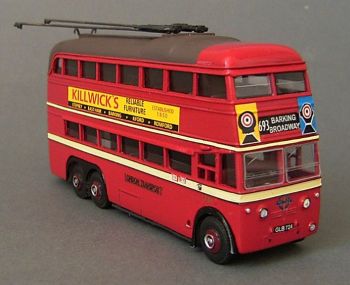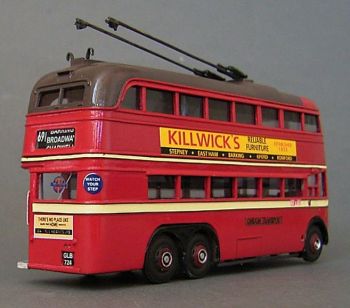 |
 |
LITTLE BUS COMPANY 6 Appleyard, Haworth Close, Halifax, HX1 2NN. Tel: 01422 301600 E-mail: |
 |
 |
LITTLE BUS COMPANY 6 Appleyard, Haworth Close, Halifax, HX1 2NN. Tel: 01422 301600 E-mail: |
|
|
|
|
|
TBSA |

|
||||||||||||
 |
History Having successfully introduced
trolleybuses on two routes in 1935, Durban Corporation Transport (South Africa) embarked
on a programme of tram to trolleybus conversion. In the late-1930s a series of orders for
3-axle double-deck trolleybuses were placed with British manufacturers, culminating in an
order for 42 Leyland TTB5 trolleybuses equipped with Metropolitan Cammell Carriage and
Wagon metal framed bodies. These would feature a front exit with air-operated sliding door
for the lower saloon passengers, full drop side windows, darkened glass in the upper
sections of the windows to combat the heat of the tropical Natal sun, and a special rack
for carrying sea angler's fishing rods at the rear! |
|||||||||||||
| Enemy action, early in World War II, caused substantial
damage to London and its transport systems. Many trolleybuses were lost. The shortfall was
to some extent made up by borrowing vehicles from fleets whose transport needs had
declined as a result of wartime constraints. Trolleybuses from Bournemouth appeared on the
streets of east London. A kit to model those trolleybuses has
already been produced by Little Bus Company. Other enemy action placed severe limits on
the availability and success of transportation to remote countries. Consequently orders
for trolleybuses made by both Durban and Johannesburg, in South Africa, could not be
shipped and it was agreed that the buses would be supplied instead to London Transport,
where they replaced the Bournemouth trolleybuses. This direct replacement was, perhaps,
something of a coincidence, as the Bournemouth buses had been located on relatively
lightly-used east London routes, because their lesser seating capacity would have a
smaller detrimental effect on service, whereas the South African vehicles, which were all
8ft wide, were located on those same routes because they were remote from central London
congestion. The South African trolleybuses were sufficiently successful that they
continued in service until withdrawn as part of the general dismantling of the London
trolleybus system.
|
||||||||||||||
The Vehicles The Durban vehicles
were placed by London Transport in two separate classes, which differed primarily in their
motors. The SA1 class had GEC motors and the SA2 class had Metrovick motors. As required
by Durban, the vehicles had sliding front doors as well as open rear platforms. In London
service these doors were initially locked shut, but were eventually paneled over. The
bodies were of quite different appearance to the standard London vehicles and had several
features to suit use in a rather warmer climate. The chassis were of Leyland manufacture
and so were familiar to London Transport, unlike the preceding Bournemouth buses which had
Sunbeam chassis. As already mentioned, at 8ft wide, and thus illegal in Britain at the
time, the buses required special dispensation to operate. This was compounded by the fact
that they also exceeded current weight limits. |
 |
|||||||||||||
In London, they were divided into two classes
corresponding to their electrical equipment:
|
||||||||||||||
The vehicles which actually reached Durban in 1940 and 1941 were:
|
||||||||||||||
London: some of the SA1 class were withdrawn prematurely, reportedly due to their weak bodywork, but all members of the SA2 class remained in service until the end of trolleybus operations from Ilford Depot and the withdrawal of services 691 and 693 on 18th August 1959. Although the last withdrawals were retained by the breaker until early 1960, in the hope of resale abroad, all the vehicles were scrapped. Actual withdrawal dates were: -
March 1955: 1730, 1732, 1733
The Little Bus Company kit nominally represents the SA2 class, but as there is no significant difference in appearance between the SA1 and SA2 classes (with minor exceptions in the case of 1722, the prototype) there seems to be no reason not to build the model as an SA1. The kit shows the front door in panelled over condition and is generally representative of the vehicles as they appeared in post-war service. The model is very straightforward to build and, as there were no significant variations during the life of the vehicles, there are no alternative parts supplied. As the vehicles had concealed trolley gantries the poles must be inserted directly into the resin casting.
Master for the model designed and built by Rod Blackburn for Little Bus Company Model built and finished by Tony Asquith
|
||||||||||||||
 Check Price and Availability of this Kit This link will take you to the Little Bus
News Page
|
||||||||||||||
© 2001-2007 All rights
reserved.
LBC Models Ltd
Registered in
Registered Office
6 Appleyard, Haworth Close,
Halifax, HX1 2NN.
Please use this link for
Please use this link
if you have had any problems using this website
(Dead links, Photos which do not appear, etc.).